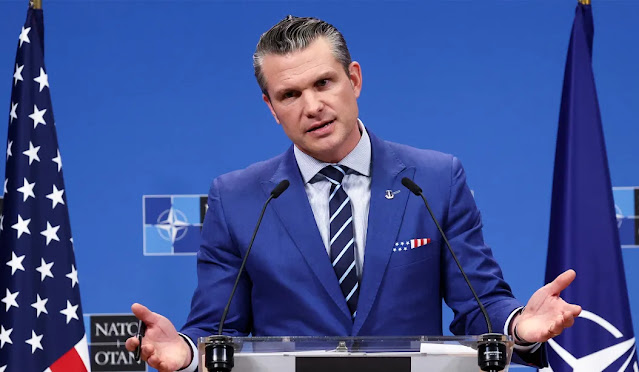Pete Hegseth’s tenure as Secretary of Defense was always going to attract scrutiny. His emphasis on “de-wokifying” the military, empowering enlisted troops, and fostering a merit-based culture of excellence has resonated with many conservatives who believe the Pentagon has become bloated and distracted by social policies. However, his handling of a major policy announcement regarding Ukraine has left both allies and domestic observers questioning the coherence of the Trump administration’s foreign strategy.
A Dramatic Policy Shift on Ukraine
Hegseth’s remarks at NATO headquarters initially signaled a notable shift in U.S. policy on Ukraine, one that appeared to align with a more restrained, transactional approach to foreign engagement. In prepared comments before allied defense ministers, he declared that while the United States remained committed to supporting a “sovereign and prosperous Ukraine,” it was unrealistic to expect a return to Ukraine’s pre-2014 borders. Furthermore, he stated that NATO membership for Ukraine was “not a realistic outcome” of any potential peace settlement.
These remarks immediately raised eyebrows. For years, U.S. officials had publicly insisted that Ukraine’s territorial integrity, including Crimea and the Donbas region, was non-negotiable. Hegseth’s language suggested a departure from that stance—one that could be interpreted as an early concession to Russia without receiving anything in return.
To some, this shift represented a hard-nosed acknowledgment of geopolitical realities. After nearly two years of war, a full Ukrainian victory remains uncertain, and some Western policymakers have privately debated whether a negotiated settlement—one that might involve territorial concessions—could be the most pragmatic path forward. But others, including officials in Kyiv, likely saw it as premature appeasement, undermining Ukraine’s leverage in ongoing negotiations.
The Rapid Reversal
Then, in a stunning reversal, Hegseth appeared to walk back his statements less than 24 hours later during a Q&A session at NATO HQ. When asked about his comments regarding Ukraine’s NATO membership, he offered a notably different tone.
“Well, I would say—I want to be clear about something as it pertains to NATO membership not being a realistic outcome of negotiations,” he said with what observers described as a sheepish grin. “That was something that was stated as part of my remarks here, as part of a coordination with how we’re executing these ongoing negotiations, which are led by President Trump.”
He then distanced himself from setting policy altogether, stating:
"All of that said, these negotiations are led by President Trump—everything is on the table in his conversations with Vladimir Putin and Zelensky. What he decides to allow or not allow is at the purview of the leader of the free world, of President Trump. So I’m not going to stand at this podium and declare what President Trump will do or won’t do—what will be in or what will be out—what concessions will be made or what concessions are not made. . . . It’s not my job as the secretary of defense to define the parameters of the president of the United States as he leads some of the most complex and consequential negotiations in the world."
The about-face was unmistakable. What had been presented as a firm, administration-backed policy shift just a day earlier was now reframed as merely one possible outcome among many—entirely dependent on President Trump’s ongoing negotiations.
Confusion and Concern in Washington and Beyond
The rapid reversal raises troubling questions. Who approved Hegseth’s initial speech? Was it cleared by the White House? Did President Trump personally endorse the initial message only to reverse course after backlash? Or was the Pentagon simply out of sync with the broader administration strategy?
If Hegseth was speaking out of turn, it would suggest a troubling lack of coordination between the Department of Defense and the White House on one of the most pressing security issues of the moment. If, on the other hand, the White House did approve his remarks but then abruptly changed its stance, that signals a degree of volatility that could undermine U.S. credibility on the world stage.
Allies in Europe, particularly in Eastern NATO member states, will likely see this episode as an unsettling sign of inconsistency. Ukraine, too, is watching closely. If Kyiv perceives that the U.S. is no longer firmly backing its goal of reclaiming all occupied territories, it could shift both diplomatic and battlefield calculations.
A Leadership Test for Hegseth
Beyond the policy implications, this episode is a critical test for Hegseth’s leadership. His strengths—his ability to connect with troops, his media savvy, and his clear articulation of a vision for military reform—are not in question. But his role as Secretary of Defense is not merely to set a cultural tone within the military. It is to be a disciplined, authoritative voice on matters of national security and to ensure that Pentagon messaging aligns with the broader objectives of the administration.
By delivering a major policy pronouncement and then almost immediately walking it back, Hegseth has raised concerns about his grasp of that responsibility. His performance in the coming weeks will be closely scrutinized—not just by the media, but by allies, adversaries, and the administration itself.
For a team that campaigned on bringing clarity and strength to U.S. foreign policy after what they described as the "weakness" of the Biden administration, this episode is a concerning early misstep. If the Trump administration wants to project the image of a well-oiled machine, it must ensure that its top officials speak with one voice—and that they do so with credibility.
















